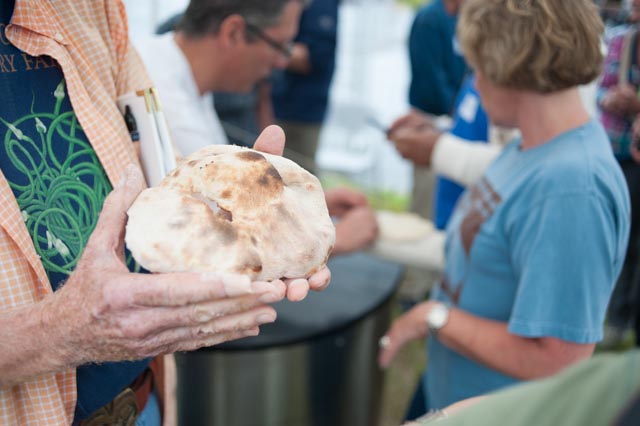 A few years ago we discovered an endangered heritage wheat (Red Fife), that became the canvas of our creativity and a gateway to the farmers markets. Evelyn’s Crackers is in our 5th year and can still be found at several farmers markets in Toronto. Our crowning achievement was representing Canada at the Slow Food Conference in Italy and being recognized for our advocacy of heritage grains and establishing a link from grower to consumer. We realize being recognized at the global level for our dedication is an honor, but more importantly it raises awareness of these forgotten grains and provides initiatives for growers, millers and food artisans to use them. Each year more farmers markets are forming and for vendors to continue to make long term commitments there needs to be a more focus on the ability of the farmers markets to grow small businesses.
A few years ago we discovered an endangered heritage wheat (Red Fife), that became the canvas of our creativity and a gateway to the farmers markets. Evelyn’s Crackers is in our 5th year and can still be found at several farmers markets in Toronto. Our crowning achievement was representing Canada at the Slow Food Conference in Italy and being recognized for our advocacy of heritage grains and establishing a link from grower to consumer. We realize being recognized at the global level for our dedication is an honor, but more importantly it raises awareness of these forgotten grains and provides initiatives for growers, millers and food artisans to use them. Each year more farmers markets are forming and for vendors to continue to make long term commitments there needs to be a more focus on the ability of the farmers markets to grow small businesses.
Within our first season at the farmers market we were contacted by a local butcher to merchandise our crackers based on their customer requests. To sustain our business, especially during the off-market season, we have to sell to retailers. The costs associated with wholesaling are much more and the margins are much less. For example, if I have 10 stores that order $100 every month that is $1000. 50% is the cost to make the crackers, the labels, packaging, bar-code and nutritional analysis. That does not factor in the cost of delivery, or any credits that would be given for breakage or expiration, not to mention chasing down past due invoices, or the possibility of not being paid due to insufficient funds. Some retailers will not pay before 60 days, therefore greatly affecting cash flow. The exposure in stores raises the awareness of the brand but there are many more costs involved.
To generate significant revenues you are looking at at least 200 accounts. That number of stores requires a distributor who takes up to 35%, on top of the 40-60% of the retailer takes drives up the retail price significantly. It doesn’t take long to see the pressures within the industry to source cheaper and cheaper ingredients to make up for these extra costs. To continue using heritage grains grown organically and nearby we offset these extra costs by delivering to stores ourselves and selling at farmers markets.
It takes 2-3 years to establish a following, however the benefits to selling at farmers markets is the ability to build a brand, have instant feedback and to experiment with flavors and methods of production. We offer many more items at the farmers markets than we ever would through our retail partners. Our margins are better and we can connect and sell directly to consumers. Ironically, our application was rejected for at a new market starting its second season this year because a few of our crackers are being sold in a retail store nearby. Their reasoning, “You are too big for the market.”
There are significant failures to see the importance of farmers markets it’s ability to sustain small businesses. There is a failure to understand the food system and how it relates to the small producer and the challenges associated with competing with the agri-industry for prices and market share. Farmers market vendors should be encouraged to wholesale. You cannot build a local food economy one day a week, 5 months out of the year. The farmers market needs to move beyond the impulse buy because small businesses can make an impact. To date, Evelyn’s Crackers has purchased over 3 tons of Ontario grains. There is serious disconnect when our limited success strikes against us.
New farmers market organizers are missing opportunities to look beyond the market. They are getting caught up in surveys instead of being leaders and working towards a long term vision and creating a market identity. Not very often someone with “skin in the game,” or vendors making a living in the farmers markets are part of the decision process, or creating priorities of the market, or who should attend. Those who have the most at stake should have the biggest voice.
The farmers market has been part of every day in every corner of the globe for eons. We, in North America, are rediscovering ours. Evelyn’s Crackers is only one example of what is coming out of the farmers market and as one of the first artisans to use endangered grains we certainly cannot become big enough.































